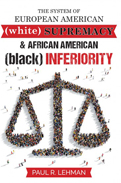
 |
The System of European American (white) Supremacy and African American (black) Inferiority
by Paul R. Lehman
LitFire Publishing
The goal of this book is to present the argument for a less offensive approach to the way human beings address and speak about each other. According to Lehman, the history of racism begins with the Anglo-Saxons of the British Isles. It arrived in America with the Puritans and other European settlers. Demeaning an ethnic group whose skin was not white included both Native Americans and slaves from Africa. This book traces US racism through the history of slave owners in the North and South. The difference was that Northerners valued the souls of their slaves. The Southerners considered them property and less than human. The author explains dog whistle terms, like "inner city" and "illegal alien," that media and politicians use to incite animosity. This generation is familiar with phone cameras that capture physical abuse by police or difficulties in classifying color on forms and census reports. The author assumes that most whites were scared to have a black president in the White House.
Lehman’s argument, over eleven chapters in length, reveals his compassion for others. Likewise, it shows that his primary concern is to prevent the universal consequences of driving further apart two significant people groups. His in-depth index is a useful tool for any reader who wants to cite arguments, quotes, and data. Some readers may think the author is quibbling over words. However, this 158-page book demonstrates the frequency with which white people use terms that reveal bigotry (46 times) and bias (43 times). The author prefers to use ethnic/ethnicity, mentioned 122 times in the book, and believes terms that attempt to classify and/or diminish the value inherent in each human being should be replaced. This can only happen once the value system responsible for this misuse over the past centuries is removed.
RECOMMENDED by the US Review